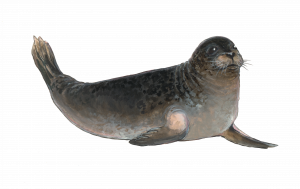Pinnipeds are members of the order Carnivora, and even contribute its largest representatives. With up to 6 meters in length and a whopping 4 tons, the Southern elephant seal reigns supreme among them (though the blue whale still holds the crown as the largest carnivore overall). The smallest member of the seal club is the freshwater Baikal seal with just over one meter in length and 45 kg.
Surprisingly, the closest relatives of these marine mammals are not whales or manatees, but their land-dwelling cousins – bears, otters, and weasels. While pinnipeds share some marine adaptations with cetaceans and sirenians, they floated along their own evolutionary path, becoming unique semi-aquatic inhabitants of both land and sea.

Know Your Pinnipeds
The pinniped family tree has three distinct branches: true seals, eared seals, and the walrus.
Traits All Pinnipeds Share
- Amphibious Lifestyle: Adapted for life both in water and on land/ice.
- Flippers: Limbs evolved into flippers for efficient swimming.
- Streamlined Bodies: Sleek shapes for reduced drag underwater.
- Anti-Cold Adaptations: Blubber and fur for insulation and energy storage.
- Diving Experts: Exceptional breath-holding capabilities and big, sensitive eyes for dim and murky conditions.
- Vibrissae (Whiskers): Sensitive tools for detecting prey underwater.
- Social Tendencies: Group-oriented behaviors for mating, resting, and protection.
How to Tell Them Apart
- Does it have tusks? It’s a walrus!
- Does it have visible ear flaps? It’s an eared seal (a sea lion or a fur seal – fur seals can have their ear flaps hidden under their fur though!)
- Does it “walk” on land using its hind flippers almost like feet? It’s an eared seal! They are able to rotate their pelvis to “walk” and can be very quick on land!
- Does it move on land by bouncing on its belly and using its front flippers? It’s a true seal. This awkward but adorable way of locomotion is called “galumphing”.
- Does it have fur-covered front flippers with long claws? It’s a true seal! (Eared seals have skin-covered front flippers with short claws.)
At the moment, you can visit the first two of the 34 species of seal for more detailed information. More to come!
| Species Name | Scientific Name | Habitat | Status |
|---|---|---|---|
| Phocidae: True seals are sleek swimmers and divers, using hind flippers for propulsion. | |||
| Harbor Seal | Phoca vitulina | Northern Hemisphere | Least Concern |
| Grey Seal | Halichoerus grypus | North Atlantic Ocean | Least Concern |
| Spotted Seal | Phoca largha | North Pacific Ocean | Least Concern |
| Harp Seal | Pagophilus groenlandicus | North Atlantic and Arctic Ocean | Near Threatened |
| Hooded Seal | Cystophora cristata | North Atlantic and Arctic Ocean | Endangered |
| Bearded Seal | Erignathus barbatus | Arctic Ocean | Near Threatened |
| Ribbon Seal | Histriophoca fasciata | North Pacific Ocean | Least Concern |
| Ringed Seal | Pusa hispida | Arctic Ocean and adjacent seas | Least Concern |
| ⤷ Saimaa Ringed Seal | Pusa hispida saimensis | Lake Saimaa, Finland | Critically Endangered |
| ⤷ Ladoga Seal | Pusa hispida ladogensis | Lake Ladoga, Russia | Vulnerable |
| Baikal Seal | Pusa sibirica | Lake Baikal, Siberia | Least Concern |
| Caspian Seal | Pusa caspica | Caspian Sea | Endangered |
| Mediterranean Monk Seal | Monachus monachus | Mediterranean Sea and Eastern Atlantic | Endangered |
| Hawaiian Monk Seal | Neomonachus schauinslandi | Hawaiian Archipelago | Endangered |
| Northern Elephant Seal | Mirounga angustirostris | North Pacific Ocean | Least Concern |
| Southern Elephant Seal | Mirounga leonina | Southern Ocean | Least Concern |
| Leopard Seal | Hydrurga leptonyx | Antarctic waters | Least Concern |
| Weddell Seal | Leptonychotes weddellii | Antarctic waters | Least Concern |
| Ross Seal | Ommatophoca rossii | Antarctic waters | Least Concern |
| Crabeater Seal | Lobodon carcinophaga | Antarctic waters | Least Concern |
| Otariidae: Eared seals rely on their front flippers for propulsion and are agile on land. | |||
| Northern Fur Seal | Callorhinus ursinus | North Pacific Ocean | Vulnerable |
| California Sea Lion | Zalophus californianus | North America's coasts | Least Concern |
| Steller Sea Lion | Eumetopias jubatus | North Pacific Ocean | Near Threatened |
| Brown Fur Seal | Arctocephalus pusillus | Southern Africa and Australia | Least Concern |
| ⤷ Cape Fur Seal | Arctocephalus pusillus pusillus | Southern African coasts | Least Concern |
| ⤷ Australian Fur Seal | Arctocephalus pusillus doriferus | Southern Australian coasts | Least Concern |
| New Zealand Sea Lion | Phocarctos hookeri | New Zealand | Endangered |
| South American Sea Lion | Otaria flavescens | South American coasts | Least Concern |
| Antarctic Fur Seal | Arctocephalus gazella | Southern Ocean | Least Concern |
| Guadalupe Fur Seal | Arctocephalus townsendi | Eastern Pacific Ocean | Endangered |
| Galápagos Fur Seal | Arctocephalus galapagoensis | Galápagos Islands | Endangered |
| Subantarctic Fur Seal | Arctocephalus tropicalis | Subantarctic waters | Least Concern |
| New Zealand Fur Seal | Arctocephalus forsteri | New Zealand and southern Australia | Least Concern |
| Juan Fernández Fur Seal | Arctocephalus philippii | Juan Fernández Islands | Near Threatened |
| South American Fur Seal | Arctocephalus australis | South American coasts | Least Concern |
| Australian Sea Lion | Neophoca cinerea | Southern Australian coasts | Endangered |
| Galápagos Sea Lion | Zalophus wollebaeki | Galápagos Islands | Endangered |
| Odobenidae: Walruses are Arctic giants, renowned for their tusks and social behavior. | |||
| Walrus | Odobenus rosmarus | Arctic regions | Vulnerable |
